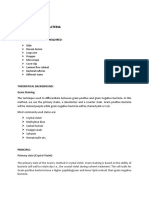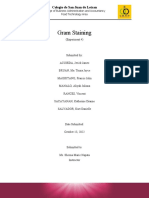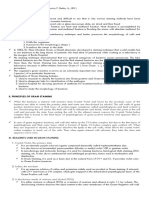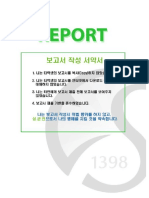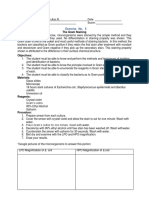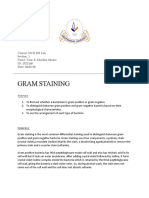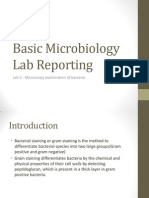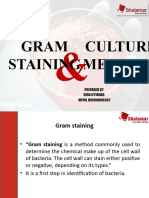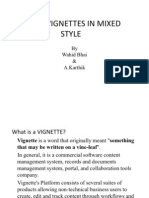FST-305 Cereal Milling & Legumes
FST-305 Cereal Milling & Legumes
Uploaded by
Rishav GautamCopyright:
Available Formats
FST-305 Cereal Milling & Legumes
FST-305 Cereal Milling & Legumes
Uploaded by
Rishav GautamOriginal Title
Copyright
Available Formats
Share this document
Did you find this document useful?
Is this content inappropriate?
Copyright:
Available Formats
FST-305 Cereal Milling & Legumes
FST-305 Cereal Milling & Legumes
Uploaded by
Rishav GautamCopyright:
Available Formats
Food microbiology practicals, Dept.food science &tech.
AIM : To perform gram staining of given sample.
MATERIAL REQUIRED : Glass slides, bunsan burner , cotton , sample , microscope.
REAGENTS REQUIRED: Crystal violet dye, iodine, alcohol (95% ethyl alcohol), saffranin
dye
PRINCIPLE: Gram staining is most widely staining technique used in m/o examination. It
was discovered by Danish scientist and physician Hans Christain Joachin Gram in 1884. This
technique differentiates bacteria in 2 groups i.e. Gram positive and Gram negative bacteria.
The procedure is based on the ability of m/o to retain colour of the stain during Gram
reaction. Gram negative bacteria are decolourised by alcohol losing the colour of primary
stain , purple. Gram positive bacteria are not decolourised by alcohol and will remain as
purple. After decolourisation stop , a counter stain is used to impart pink colour to the gram
negative m/o.
Gram positive bacteria have a thick mesh like cell wall which is made up of peptidoglycan
(50-90%) of cell wall, which stain purple. Gram negative bacteria have a thinner layer of
peptidoglycan (10% of cell wall) and lose the crystal violet iodine complex during
decolourisation with alcohol rinse but retain the counter stain safarin thus appearing reddish
or purple.
STAIN REACTION :
1. Application of crystal violet to heat fixed smear :
CV dissociates in aqueous solution into CV+ and Cl- ions. These two penetrate the cell
wall and cell membrane of both gram positive and gram negative . CV+ interact with
negative component of bacterial cell and stain it purple.
2. Addition of gram iodine :
Iodine acts as a mordant and a trapping agent. A mordant is a substance that increase
the affinity of cell wall for a stain by binding to primary stain , thus forming a
insoluble complex that get trapped in cell. During the reaction CV-I compex is formed
and all the cells turn purple.
3. Decolourization with ethyl alcohol :
Alcohol dissolve the lipid outer membrane of gram negative bacteria, thus leaving the
petidoglycan layer exposed and increase the porosity of cell wall. The CV-I complex
is then washed away from the peptidoglycan layer leaving gram negative bacteria
colourless.In gram positive bacteria , alcohol has dehydrating effect on cell wall
causing cell wall to shrink , then CV-I complex get tightly bound into multi layered
leaving the cell with purple colour.
1
4. Counter stain with safranin dye :
The decolourised gram negative cell can be visible with a suitable counter stain which
is usually positively charged safarnin, which stained it pink.
D.A.V college, jalandhar
Food microbiology practicals, Dept.food science &tech.
PROCEDURE :1. Prepared very thin smear of sample on glass slide and heat fixed it.
2. Flooded the smeared slide with crystal violet dye. Avoid over flooding and kept it for 1
minute.
3. Washed the slide under running tap water.
4. Applied iodine solution gently all over the slide and kept for 1 minute.
5. Washed it under tap water.
6. Applied 95% ethyl alcohol all over the slide drop wise and kept for 10 second.
7. Immediately rinsed with water.
8. Finally, flooded the sample with saffranin dye to counter stain and kept for 45 seconds.
9. Washed the slide with running water.
10. Observed it under microscope.
D.A.V college, jalandhar
You might also like
- Why Undertake A Pilot in A Qualitative PHD Study? Lessons Learned To Promote SuccessDocument5 pagesWhy Undertake A Pilot in A Qualitative PHD Study? Lessons Learned To Promote SuccessMisAlNo ratings yet
- Lab 3Document6 pagesLab 3Diyana Nabila Abdul WahidNo ratings yet
- 4 Microbiology Lab Report Practical 3 PDFDocument10 pages4 Microbiology Lab Report Practical 3 PDFNurul IzzahNo ratings yet
- Pharmaceutical Microbiology: A Laboratory ManualFrom EverandPharmaceutical Microbiology: A Laboratory ManualRating: 3.5 out of 5 stars3.5/5 (3)
- Chapter 9 Technology Impact On BusinessDocument20 pagesChapter 9 Technology Impact On Businesssanchita22No ratings yet
- HBL Auto FinancingDocument21 pagesHBL Auto FinancingRizwan AhmedNo ratings yet
- Exp#5 Gram StainingDocument4 pagesExp#5 Gram StainingbahadiroztenNo ratings yet
- Gram Staining of BacteriaDocument3 pagesGram Staining of Bacteriadavid5king-3119No ratings yet
- LAB 2: Staining and Streaking: Series of Stains and Chemical Reagents To Increase Contrast and Reveal Information AboutDocument10 pagesLAB 2: Staining and Streaking: Series of Stains and Chemical Reagents To Increase Contrast and Reveal Information AboutrabkaNo ratings yet
- Gram Stain MethodsDocument24 pagesGram Stain MethodsRasha MohammadNo ratings yet
- Exp7 Pre-lab report - 최진호 (2016310092)Document5 pagesExp7 Pre-lab report - 최진호 (2016310092)임성민No ratings yet
- Gram StainingDocument3 pagesGram Stainingmike peterNo ratings yet
- SBL 1023 Lab 9 Exp Gram Staining AsepticDocument10 pagesSBL 1023 Lab 9 Exp Gram Staining Asepticapi-384057570No ratings yet
- Unit IiDocument23 pagesUnit IiMohith KothariNo ratings yet
- Staining Reaction 16-11-2016-1Document61 pagesStaining Reaction 16-11-2016-1sameera ruffaiNo ratings yet
- Report On Gram Staining 1Document7 pagesReport On Gram Staining 1Abena FlourishingNo ratings yet
- (General Microbiology) Lab Rep 4 - Gram StainingDocument15 pages(General Microbiology) Lab Rep 4 - Gram StainingFrancis MagbitangNo ratings yet
- Experiment 4 MicrobiologyDocument5 pagesExperiment 4 MicrobiologyFrancis TagnongNo ratings yet
- Lab 4 - Staining and Observation of MicroorganismsDocument9 pagesLab 4 - Staining and Observation of MicroorganismsYusof Sundang100% (1)
- Gram Staining LaboratoryDocument3 pagesGram Staining Laboratorybiancaarabila.loboNo ratings yet
- Bacterial Staining TechniquesDocument3 pagesBacterial Staining TechniquesSeerat FatimaNo ratings yet
- Staining Techniques in Microbiology.Document9 pagesStaining Techniques in Microbiology.rajendraprasadreddyNo ratings yet
- Staining TechniquesDocument9 pagesStaining Techniquesjaysand08No ratings yet
- Pre Lab7Document5 pagesPre Lab7임성민No ratings yet
- MicroPara Worksheet 5Document7 pagesMicroPara Worksheet 5Enguio Irish JeanNo ratings yet
- Lab 3 Bacterial Staining Techniques IIDocument10 pagesLab 3 Bacterial Staining Techniques IIErreneoNo ratings yet
- Differential (Gram) Staining L 2111003 - Abhishek.S - B1Document4 pagesDifferential (Gram) Staining L 2111003 - Abhishek.S - B1one2three1two34No ratings yet
- BI103 Practical 2 HandoutDocument5 pagesBI103 Practical 2 HandoutStephane FongNo ratings yet
- Gram Decolorizer (95% Ethyl Alcohol) : Adjusted As Required To Meet Performance StandardsDocument1 pageGram Decolorizer (95% Ethyl Alcohol) : Adjusted As Required To Meet Performance StandardsBhabani DasNo ratings yet
- Gram Staining PRACTICAL-1Document31 pagesGram Staining PRACTICAL-1badshahbilal81No ratings yet
- Worksheet 1 Microscopic Visualization of Bacteria Differential and Structural StainingDocument6 pagesWorksheet 1 Microscopic Visualization of Bacteria Differential and Structural StainingKyra ErniNo ratings yet
- Gram StainDocument7 pagesGram StainYani ManuelNo ratings yet
- Microbiology ExperimentDocument9 pagesMicrobiology Experiment门门No ratings yet
- Staining MethodsDocument8 pagesStaining MethodsMd Arshad100% (1)
- Chap4Demonstration of Microorganisms - SJSPDocument133 pagesChap4Demonstration of Microorganisms - SJSPMaryangel RivalesNo ratings yet
- MicrobiologyI-lab 5 StainingDocument23 pagesMicrobiologyI-lab 5 Staining24zh2gbxb7No ratings yet
- Gram Staining:: Gram-Negative Bacteria Such As The Salmonella Typhi That Is Associated With Typhoid Fever. PurposeDocument2 pagesGram Staining:: Gram-Negative Bacteria Such As The Salmonella Typhi That Is Associated With Typhoid Fever. PurposeIravati RayNo ratings yet
- Laboratory Activity On StainingDocument4 pagesLaboratory Activity On Stainingdennise reyesNo ratings yet
- Lab 4 Staining and Observation of MicroorganismsDocument9 pagesLab 4 Staining and Observation of MicroorganismsNur NatashaNo ratings yet
- Identification of Bacteria Using Gram Staining MethodDocument7 pagesIdentification of Bacteria Using Gram Staining MethodDani MughalNo ratings yet
- Experiment 5 MIC125Document10 pagesExperiment 5 MIC125Nabila HusnaNo ratings yet
- Assignment Gram Stain.111Document6 pagesAssignment Gram Stain.111premium Shopping centreNo ratings yet
- Modul SL Specimen Collection GUS - 2021Document11 pagesModul SL Specimen Collection GUS - 2021Denden AllatifNo ratings yet
- Cell Staining: The Simple StainDocument4 pagesCell Staining: The Simple StainAitlas KhanNo ratings yet
- Exercise 8Document3 pagesExercise 8Merve Nur GülerNo ratings yet
- Laboratory Activity On StainingDocument5 pagesLaboratory Activity On Stainingdennise reyesNo ratings yet
- Gram Staining: Course: MCB 103 Lab Section: 1 Name: Noor-E-Khadiza Shama ID: 1921168 Date: 04/02/20Document5 pagesGram Staining: Course: MCB 103 Lab Section: 1 Name: Noor-E-Khadiza Shama ID: 1921168 Date: 04/02/20ShamaNo ratings yet
- Basic Microbiology Lab Reporting Gram StainingDocument26 pagesBasic Microbiology Lab Reporting Gram StainingNeayzahn AcesSka100% (1)
- MLT 415 Lab Report Gram Stain TechniquesDocument7 pagesMLT 415 Lab Report Gram Stain TechniquesYo YaNo ratings yet
- Gram Stain Lab 1Document1 pageGram Stain Lab 1m18350248No ratings yet
- Gram's Stain ReagentDocument3 pagesGram's Stain Reagentsubhaga dubeyNo ratings yet
- Am StainingDocument6 pagesAm StainingAlison 123 Parajuli 123No ratings yet
- BIO461 Practical 2Document7 pagesBIO461 Practical 2NURUL AIHAN AHMAD HILMINo ratings yet
- Gram Stain Procedure and Additional Information - Practical 1Document6 pagesGram Stain Procedure and Additional Information - Practical 1kamvajavasNo ratings yet
- Lab 4 DIFFERENTIAL & Special STAINDocument21 pagesLab 4 DIFFERENTIAL & Special STAINAAANo ratings yet
- Moyes 2009, Tinción de GramDocument8 pagesMoyes 2009, Tinción de GramVale rumazNo ratings yet
- Gram StainingDocument19 pagesGram StainingkashaffazilatNo ratings yet
- Exp7 PrelabDocument7 pagesExp7 Prelab임성민No ratings yet
- Exercise 2Document6 pagesExercise 2Louiegi AlvarezNo ratings yet
- Universiti Sains Malaysia Jib 221 Microbiology Practical 2. Simple Stain and Gram Stain TechniquesDocument3 pagesUniversiti Sains Malaysia Jib 221 Microbiology Practical 2. Simple Stain and Gram Stain TechniquesBaby girlNo ratings yet
- Final ManualDocument24 pagesFinal Manualfattima.afzal456No ratings yet
- Activity 2 - Gram Staining - GR 4Document6 pagesActivity 2 - Gram Staining - GR 4leenquishayuNo ratings yet
- Gram StainingDocument72 pagesGram Stainingtummalapalli venkateswara rao100% (2)
- From Saviour To Colonial Perpetrator Manipulating Player Empathy in Silent Hill 2 and Silent Hill OriginsDocument17 pagesFrom Saviour To Colonial Perpetrator Manipulating Player Empathy in Silent Hill 2 and Silent Hill OriginstiannixukellyNo ratings yet
- 0perational Use of Ecdis Question SetDocument17 pages0perational Use of Ecdis Question SetAbu Syeed Md. Aurangzeb Al Masum100% (3)
- ClutchDocument9 pagesClutchAndryanNo ratings yet
- Health Insurance Coverage LimitsDocument2 pagesHealth Insurance Coverage LimitsUdaya KumarNo ratings yet
- JRIZAL030 ConceptPaperFinalDocument2 pagesJRIZAL030 ConceptPaperFinalRoselle Balalitan PortudoNo ratings yet
- Document (1) Rubric EMS5Document1 pageDocument (1) Rubric EMS5nkulenzama90No ratings yet
- Instructions For Authors: Essential Title Page InformationDocument4 pagesInstructions For Authors: Essential Title Page InformationKHUSHBU BHALODIYANo ratings yet
- A Qualitative Study On Life Adjustment of Working Student Who Are Experiencing PovertyDocument20 pagesA Qualitative Study On Life Adjustment of Working Student Who Are Experiencing PovertyDanica Ormeo IIINo ratings yet
- QlikviewDocument63 pagesQlikviewDinesh KarthikNo ratings yet
- t6d Denison Vane Pumps IndustrialDocument5 pagest6d Denison Vane Pumps Industrialisrael ruiz gallardoNo ratings yet
- MSG® Centac® C700 Centrifugal Air Compressor: FeaturesDocument3 pagesMSG® Centac® C700 Centrifugal Air Compressor: FeaturesKelvin IbrahimNo ratings yet
- Chapter 5 Composing An Analytical ResponseDocument8 pagesChapter 5 Composing An Analytical ResponseqwertyzplaysNo ratings yet
- Intro Script AhmDocument2 pagesIntro Script Ahmjames domingoNo ratings yet
- Bob Proctor - Mind and Money StrategiesDocument9 pagesBob Proctor - Mind and Money StrategiesHadi Marsudianto67% (3)
- EUNIS Habitat Classification 2007 - Revised Descriptions 2012 Amended 2019Document2,453 pagesEUNIS Habitat Classification 2007 - Revised Descriptions 2012 Amended 2019Alexandra BivolaruNo ratings yet
- Frontend Lead - Skuad - JDDocument2 pagesFrontend Lead - Skuad - JDShivam DwivediNo ratings yet
- Mfe NotesDocument2 pagesMfe NotesKyle Andre MendozaNo ratings yet
- Bài tập Trọng âm của từ 2 âm tiếtDocument3 pagesBài tập Trọng âm của từ 2 âm tiếtQuỳnh NhưNo ratings yet
- (CC1) LEC-W12-Nonprotein Nitrogen CompoundsDocument10 pages(CC1) LEC-W12-Nonprotein Nitrogen CompoundsAira UsiNo ratings yet
- Measure of Central Tendency - QuestionsDocument14 pagesMeasure of Central Tendency - QuestionsMohd HannanNo ratings yet
- IAT-I Question Paper With Solution of 17EE82 Industrial Drives and Applications May-2021-Geetanjali PDocument13 pagesIAT-I Question Paper With Solution of 17EE82 Industrial Drives and Applications May-2021-Geetanjali PTej RockersNo ratings yet
- Slides For Hand Hygiene CoordinatorDocument30 pagesSlides For Hand Hygiene CoordinatorSalman Mubarak100% (1)
- Rulebook Prison OutbreakDocument48 pagesRulebook Prison OutbreakRick Snider100% (1)
- Three Vignettes in Mixed StyleDocument29 pagesThree Vignettes in Mixed StyleavadhanulakNo ratings yet
- Regna Et Gentes, Ed. H. W. Goetz, J. Jarnut, W. Pohl (2003) - Part54Document10 pagesRegna Et Gentes, Ed. H. W. Goetz, J. Jarnut, W. Pohl (2003) - Part54Radjar KiplingNo ratings yet
- Noli Me TangereDocument4 pagesNoli Me TangereGrace Cañones-TandasNo ratings yet
- Mms ProjectDocument6 pagesMms Projectapi-345467600No ratings yet







